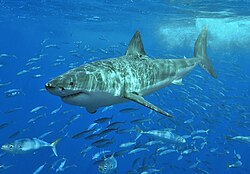Elasmobranchii
| Elasmobranchii Temporal range: Wenlock–Recent |
|
|---|---|
 |
|
| Great white shark (Carcharodon carcharias) |
|
| Scientific classification | |
| Kingdom: | Animalia |
| Phylum: | Chordata |
| Class: | Chondrichthyes |
| Subclass: |
Elasmobranchii Bonaparte, 1838 |
From a practical point of view the life-history pattern of elasmobranchs makes this group of animals extremely susceptible to over fishing. It is no coincidence that the commercially exploited marine turtles and baleen whales, which have life-history patterns similar to the sharks, are also in trouble.
Elasmobranchii (/ɪˌlæzməˈbræŋkiaɪ/) is a subclass of Chondrichthyes or cartilaginous fish. Members of this subclass are characterised by having five to seven pairs of gill clefts opening individually to the exterior, rigid dorsal fins and small placoid scales on the skin. The teeth are in several series; the upper jaw is not fused to the cranium, and the lower jaw is articulated with the upper. The details of this jaw anatomy vary between species, and help distinguish the different elasmobranch clades. The pelvic fins in males are modified to create claspers for the transfer of sperm. There is no swim bladder, instead these fish maintain buoyancy with large livers rich in oil.
The earliest elasmobranch fossils came from the Devonian and many surviving orders date back to the Cretaceous, or even earlier. Many species became extinct during the Permian and there was a burst of adaptive radiation during the Jurassic. Extant species are classified under Selachii (Selachimorpha), the modern sharks, and Batoidea, the rays, skates and sawfish.
...
Wikipedia
